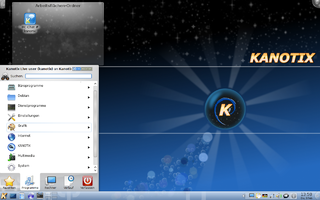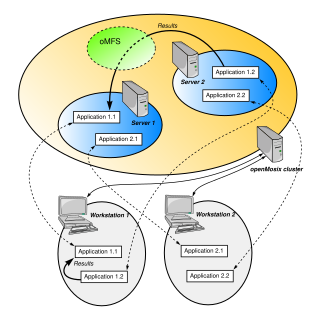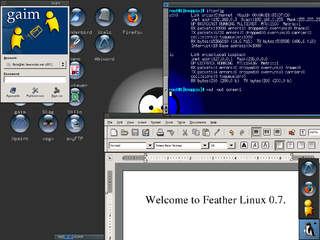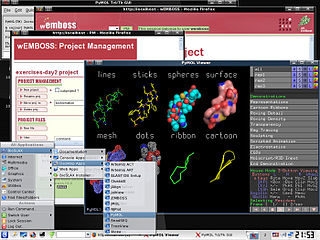
A Linux distribution is an operating system made from a software collection that is based upon the Linux kernel and, often, a package management system. Linux users usually obtain their operating system by downloading one of the Linux distributions, which are available for a wide variety of systems ranging from embedded devices and personal computers to powerful supercomputers.

KNOPPIX is an operating system based on Debian designed to be run directly from a CD / DVD or a USB flash drive, one of the first of its kind for any operating system. Knoppix was developed by, and named after, Linux consultant Klaus Knopper. When starting a program, it is loaded from the removable medium and decompressed into a RAM drive. The decompression is transparent and on-the-fly.

A live CD is a complete bootable computer installation including operating system which runs directly from a CD-ROM or similar storage device into a computer's memory, rather than loading from a hard disk drive. A live CD allows users to run an operating system for any purpose without installing it or making any changes to the computer's configuration. Live CDs can run on a computer without secondary storage, such as a hard disk drive, or with a corrupted hard disk drive or file system, allowing data recovery.

Damn Small Linux (DSL) was a computer operating system for the x86 family of personal computers. It is free and open-source software under the terms of the GNU GPL and other free and open source licenses. It was designed to run graphical user interface applications on older PC hardware, for example, machines with 486 and early Pentium microprocessors and very little random-access memory (RAM). DSL is a Live CD with a size of 50 megabytes (MB). What originally began as an experiment to see how much software could fit in 50 MB eventually became a full Linux distribution. It can be installed on storage media with small capacities, like bootable business cards, USB flash drives, various memory cards, and Zip drives.

Kanotix, also referred to as KANOTIX, is an operating system based on Debian, with advanced hardware detection. It can run from an optical disc drive or other media i.e. USB-stick without using a hard disk drive.

openMosix was a free cluster management system that provided single-system image (SSI) capabilities, e.g. automatic work distribution among nodes. It allowed program processes to migrate to machines in the node's network that would be able to run that process faster. It was particularly useful for running parallel applications having low to moderate input/output (I/O). It was released as a Linux kernel patch, but was also available on specialized Live CDs. openMosix development has been halted by its developers, but the LinuxPMI project is continuing development of the former openMosix code.

A light-weight Linux distribution is one that uses lower memory and/or has less processor-speed requirements than a more "feature-rich" Linux distribution. The lower demands on hardware ideally result in a more responsive machine, and/or allow devices with fewer system resources to be used productively. The lower memory and/or processor-speed requirements are achieved by avoiding software bloat, i.e. by leaving out features that are perceived to have little or no practical use or advantage, or for which there is no or low demand.

LinuxTag is a free software exposition with an emphasis on Linux, held annually in Germany. LinuxTag claims to be Europe's largest exhibition for "open source software" and aims to provide a comprehensive overview of the Linux and free software market, and to promote contacts between users and developers. LinuxTag is one of the world's most important events of this kind.

Kurumin Linux was a Live CD operating system based on Debian. Its main features are the advanced hardware auto-detection and a Portuguese user interface, and its main goal is ease of use. As of release 7.0, the size of the disk image is approximately 603 MB.

ALT Linux is a set of Russian operating systems based on RPM Package Manager (RPM) and built on a Linux kernel and Sisyphus package repository. ALT Linux has been developed collectively by ALT Linux Team developers community and ALT Linux Ltd.
The compressed loop device (cloop) is a module for the Linux kernel. It adds support for transparently decompressed, read-only block devices. It is not a compressed file system: cloop is mostly used as a convenient way to compress conventional file systems onto Live CDs.

Musix GNU+Linux is a discontinued live CD and DVD Linux distribution for the IA-32 processor family based on Debian. It contained a collection of software for audio production, graphic design, video editing and general purpose applications. The initiator and co-director of the project was Marcos Germán Guglielmetti.

LXDE is a free desktop environment with comparatively low resource requirements. This makes it especially suitable for use on older or resource-constrained personal computers such as netbooks or system on a chip computers.
aufs implements a union mount for Linux file systems. The name originally stood for AnotherUnionFS until version 2.

NimbleX is a small Slackware-based Linux distribution optimized to run from a CD, USB drive or a network environment. NimbleX has been praised for how fast it boots, as well as for its small disk footprint, which is considered surprising for a distribution using KDE as desktop environment. NimbleX was also remarked for its web site that allows users to generate custom bootable images using just a web browser. It was also covered in mainstream Romanian press as the first Linux distribution put together by a Romanian.

Feather Linux, created by Robert Sullivan, was a Knoppix-based operating system which fits in under 128 MB. It boots from either a CD or a USB flash drive, into a Fluxbox desktop environment. It has a wide range of desktop and rescue software, and can load entirely into RAM or be installed to a hard drive. Feather Linux contains GTK+ applications, such as AbiWord and Pidgin. Feather Linux has tried to include software that people would frequently be using on their desktop.

BioSLAX is a Live CD/Live DVD/Live USB comprising a suite of more than 300 bioinformatics tools and application suites. It has been released by the Bioinformatics Resource Unit of the Life Sciences Institute (LSI), National University of Singapore (NUS) and is bootable from any PC that allows a CD/DVD or USB boot option and runs the compressed Slackware flavour of the Linux Operating System (OS), also known as Slax. Slax was created by Tomáš Matějíček in the Czech Republic using the Linux Live Scripts which he also developed. The BioSLAX derivative was created by Mark De Silva, Lim Kuan Siong and Tan Tin Wee.
Vinux is a Linux distribution which has been specially designed for blind and partially sighted users. Specifically it is a remastered version of the Ubuntu distribution and provides users with two screen readers, two full-screen magnifiers, global font-size and colour changing facilities. The system also supports USB Braille displays.
Besides the Linux distributions designed for general-purpose use on desktops and servers, distributions may be specialized for different purposes including computer architecture support, embedded systems, stability, security, localization to a specific region or language, targeting of specific user groups, support for real-time applications, or commitment to a given desktop environment. Furthermore, some distributions deliberately include only free software. As of 2015, over four hundred Linux distributions are actively developed, with about a dozen distributions being most popular for general-purpose use.















